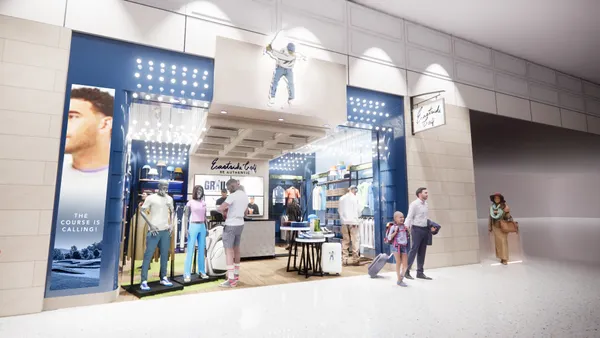The holidays offer a plethora of sounds, smells and sights, whether it’s the scent of a Thanksgiving turkey, the taste of gingerbread cookies fresh from the oven or eggnog warming on the stove, certain tastes and smells can’t help but be associated with important shopping events.
Likewise, snowflakes, garlands, wreaths and seasonal music never cease to bring to mind thoughts of winter — and with them, the gifts intended for friends, family, pets or charity. So how do retailers harness these sensual cues to make an emotional connection with holiday shoppers?
The process is more complicated than one might think, according to Danny Turner, global senior vice president of creative programming at Mood Media. In Turner’s view, not only do holiday playlists require timing that is well thought-out, but retailers should be developing a complete strategy around the music they choose to blast through their speakers during the holiday season.
"Some of the most disjointed experiences take place when holiday music is there just because they feel like 'this is what we should be doing right now,'" Turner said. The choice of what themed music to play, and when to start playing it, can be alienating to shoppers of not done thoughtfully.
That point extends to all of the more atmospheric elements of retail — sight, smell, taste, touch — and the choices that retailers make could affect not only who enters or does not enter the store, but also how customers feel while shopping and how much they’re willing to spend.
Say no to all-Christmas, all the time
It may seem like as soon as Halloween ends, the holiday music begins, but according to Mood Media that’s not the way to go. Holiday strategies to create atmosphere should adjust according to both the time and the brand — and retailers should avoid going all-in on Christmas carols as soon as the cranberry sauce and sweet potatoes are cleared away.
"It’s a lot like getting into a hot bathtub — you don’t just jump right in," Turner said. "When it makes sense to begin incorporating holiday music, we don’t start off at 100%. We use an increasing amount of holiday music throughout the holiday season."
To that end, it’s important not to overdo it. A study by Mood Media in June revealed that music and atmosphere are key elements in bringing shoppers to brick-and-mortar stores and the right music can have a serious impact on how customers feel. According to the study, the majority of U.S. consumers think music makes the shopping experience more enjoyable (84%), improves their mood (81%) and makes them "feel like it’s a brand they can relate and connect to" (70%).
"It’s a great balance, from a music perspective. You want to have things moving in a positive, forward-moving tempo. But it’s very very easy to fall into a trap of frenetic energy and that’s the last thing you need in a retail environment."

Danny Turner
Global Senior Vice President of Creative Programming at Mood Media
The potential for making a deep emotional connection — something millennials value more and more, according to a study by the Fashion Institute of Technology — is clearly there. Indeed, according to Mood Media, it’s the younger consumers who care the most about atmosphere. One in three U.S. consumers between the ages of 18 and 24 said that the "atmosphere and experience" of a store is their top reason for shopping in-store instead of online.
Paying attention to store atmosphere isn't an entirely new thing, either. According to a research paper published in the African Journal of Business Management in 2011, "store atmosphere can definitely impact customers' positive emotions significantly," especially intangible elements, aspects of design and visual stimulus. The study, which surveyed 358 about the atmosphere of chain store supermarkets, found that intangible factors, such as "music, noise, room temperature, clothing and attitude of service personnel etc. are also considered by customers as critical factors that will influence their behaviors," the paper states.
But diving too fast into holiday music can be the wrong step to take and retailers should be wary of what kinds of holiday music they’re using; religious or Christmas-oriented music, for example, could isolate shoppers. And the retail environment is chaotic enough without the same jolly tunes blasting over the loudspeaker hour after hour. The average dwell time also comes into play here and music strategies should be adjusted based on how long the retailer has to "cement an experience," according to Turner.
"It’s a great balance, from a music perspective," Turner explained. "You want to have things moving in a positive, forward-moving tempo. But it’s very very easy to fall into a trap of frenetic energy and that’s the last thing you need in a retail environment … you don’t want it to be a constant barrage."
Visuals and scents follow a similar pattern, with many retailers opting for a more generic, seasonal approach than Christmas-specific marketing. According to Jaime Bettencourt, senior vice president of business development at Mood Media, retailers should focus window displays and signage for winter promotions and deals during the holiday season. Even the store’s scent should "evoke something like a familial gathering" rather than a "Christmas smell."
"It’s hard to measure, what that does," Bettencourt said, in regards to how fragrances can affect a shopper’s experience. "But it really emphasizes the store experience. I don’t know if that seems like a timely thing to some people, but when I think about things that [retailers] overlook, I think scent is one of them and something that people could quickly make an adjustment on."
Several studies cited by Psychologist World follow a similar trend, with one revealing that although scent by itself had a negative effect on customer emotions, it created an atmosphere that actually lifted customers' emotions when paired with music.
Today is my favorite day of the holiday season. The day when the Christmas music in the stores stops!!!
— Charles Haire (@charlesphaire) December 26, 2016
The trend toward seasonal atmosphere adjustments has made its way into retail playlists as well, with many retailers trending towards songs that speak more to "seasonality and aspects of family gatherings, celebrations [and] the changing of the seasons," according to Turner, while straying away from "overt holiday themes."
A holiday strategy to fit the brand
When you go to Hot Topic, you probably expect to hear rock music; when you go to American Eagle or Forever 21, you might expect Indie or Top 40; and when you go to a department store, it’s anyone’s guess what kind of music you’ll get, but it probably won’t be rock. To put it simply: different brands have different vibes.
It’s something consumers know and it’s something retailers should take care to notice, especially during the holidays, when it’s oh-so-tempting to run with the crowd and play Bing Crosby, Dean Martin and Mariah Carey till the cows come home.
"We’ve always gravitated toward holiday music after Black Friday but the question is: 'is holiday music appropriate for your brand?'" Turner said. "If the adoption of seasonal music fits with the brand DNA, then absolutely let’s explore it. Some of the most disjointed experiences take place when holiday music is there just because they feel like 'this is what we should be doing right now.'"
In the end it goes back to the old adage: "know thyself" — something that continues to be relevant in marketing — which retailers need to examine before they start pulling out all the stops to get stores buzzing. Some brands just don’t fit with holiday music and, in Turner’s view, that’s not a problem. One of the most important aspects of maintaining brand identity is making it consistent — across seasons, platforms and even sensory experience.
"It’s those instagrammable experiences that make people want to go to the store versus just having to go to the store."

Jaime Bettencourt
Senior Vice President of Business Development at Mood Media
"They’re expecting a consistent feel regardless of what way they come into the brand," Bettencourt said, as she discussed differences between mobile and in-store experiences. She later added that, "customers react differently based on what they expect from the brand. If it’s a brand that uses promotional techniques a lot, then they can amplify that [during the holidays]. If it’s a store that uses inspiration to make you feel like you can do more or be more, then that’s how people will be drawn in."
As experiences become increasingly important to get shoppers to the mall, retailers should focus not only on creating personal connections with the customer, but also tailoring experiences so they fit in with the brand’s message, according to Bettencourt. That could prove difficult, though. In the past, retailers have struggled with adjusting to experience, according to a report published by the Washington Post during last year's holiday season, and only 22% of CMO’s feel like they’re actually good at emotionally engaging customers through their content, a study by Persado found.
That being said, customers are still drawn to brick-and-mortar stores and the majority choose physical storefronts over online shopping because they enjoy the tactile experiences that they find there — Retail Dive's own consumer survey found that 62% of consumers go to the stores primarily to see, touch and feel products. Similarly, Mood Media found that when music is partnered with visuals and scent to "create a branded in-store atmosphere," 59% of shoppers are more likely to revisit the store and 54% are more likely to recommend it to others. Those numbers jump to 72% and 65% respectively for consumers aged 18-24.
Retailers should capitalize on that, Bettencourt said, and she expects that moving into the holiday season we’ll see more brands keeping their marketing strategy "authentic and true to their brand." When it comes to adjusting store atmosphere for the holidays, Bettencourt also expects to see retailers "creat[ing] a story that really resonates with the senses" — something that is currently more prevalent in flagship stores than at other storefronts.
"They have all of these beautiful displays and these experiences that people feel inspired by and want to take a picture of," Bettencourt said of flagships. "It’s those instagrammable experiences that make people want to go to the store versus just having to go to the store."
Catering to the (adult) shopper
The holidays bring together several different types of holiday shopper. There’s the determined shopper, who knows exactly what they want and plans to rush in with a list and rush out 10 minutes later with everything they need. But then there’s also those who shop for pleasure — who don’t want to be forced in and forced out to make way for the next crowd and are out to enjoy their holiday shopping.
At this point, the store experience should really be catered to each individual customer, according to Mood Media. Retailers should be ready to adjust their tactics depending on what a given shopper is looking for, but no matter the case, the experience should always be unique.
"From the shortest transaction to the longest transaction, it’s about making it memorable and about making that brand connection. And then fostering that relationship for the next nine months," Turner said.
There are many ways to do that — one of which involves making adults feel comfortable enough to shop. With parents still holding the holiday purse strings, a lot can be done to make sure that the store is a fun and exciting place for them to go — and dealing with the kids is a part of that. Bettencourt notes that many stores now have digital displays playing branded content or something else for the kids to watch while their parents shop, along with cupcakes or other treats to make it a "party atmosphere."
It doesn’t end there, though. Some retailers and mall owners are going the extra mile to make holiday shopping as exciting for adults as it can be for the kids. The "grown up equivalent of the mall Santa," according to Bettencourt, is an interactive and exciting retail environment that touches the senses as much for adults as it does for children.
These events range from, "bringing bands on site to play live holiday-themed music during the shopping season" to "handing out free cider and cookies — basically, providing shoppers with a unique seasonal experience they typically don’t get, while also tapping into their emotional connections to the holidays," Bettencourt said.
I've worked in two department stores, always during the holiday season. My hatred for Christmas music is real.
— Ice Boy (@HRCage) December 22, 2016
That being said, retailers can also make simple changes to the in-store experience in order to make it as helpful and enjoyable as possible. For one thing, retailers that plan on hiring seasonal staff should make sure that they’re well-versed on the brand’s products and can offer product or technology demos — something a shopper will have a harder time finding online.
"You’re going into the store because you want to be there versus you have to go in," Bettencourt said, explaining that seasonal hires should reflect that ethos. "It’s really important to make sure that they are brand ambassadors and give that something extra."
This story is part of our ongoing coverage of the 2017 holiday shopping season. You can browse our holiday page and sign up for our holiday newsletter for more stories.














